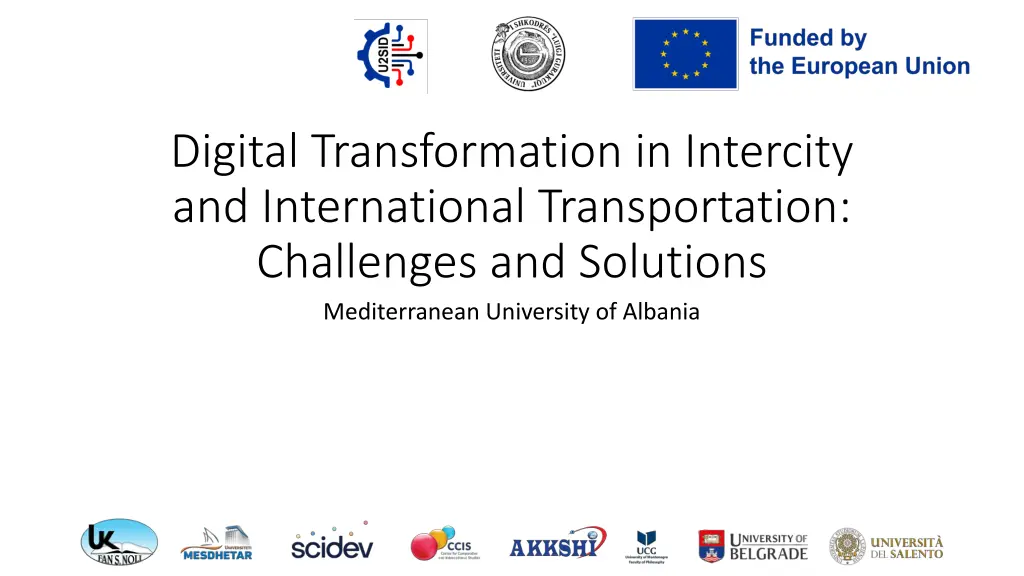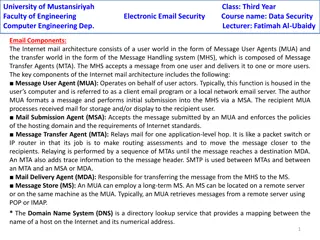
Transforming Public Transportation in Albania: Digital Solutions for Efficiency
Addressing the challenges in Albanian public transport, this project focuses on implementing a centralized digital platform to optimize operations, improve passenger experience, and enhance efficiency. Through a comprehensive system architecture and proposed solutions, the aim is to revolutionize intercity transportation in Albania.
Download Presentation

Please find below an Image/Link to download the presentation.
The content on the website is provided AS IS for your information and personal use only. It may not be sold, licensed, or shared on other websites without obtaining consent from the author. If you encounter any issues during the download, it is possible that the publisher has removed the file from their server.
You are allowed to download the files provided on this website for personal or commercial use, subject to the condition that they are used lawfully. All files are the property of their respective owners.
The content on the website is provided AS IS for your information and personal use only. It may not be sold, licensed, or shared on other websites without obtaining consent from the author.
E N D
Presentation Transcript
Digital Transformation in Intercity and International Transportation: Challenges and Solutions Mediterranean University of Albania
Introduction The absence of digitization in Albanian public transport presents significant issues. Manual processes lead to inefficiencies, delays, and increased costs.
Problem Statement Lack of a centralized digital platform for public transport in Albania results in poor accessibility, inefficiencies, and elevated operational expenses. Company : Magus Group Albania
Objectives 1. Develop a centralized digital platform 3. Optimize operational resources 2. Implement online booking and payment 4. Enhance passenger experience
Methodology Qualitative: Interviews with stakeholders Mixed-methods approach: Quantitative: Data on operational inefficiencies & satisfaction metrics
Proposed Solution A centralized platform providing Fleet Real-time route information Online booking and payments management tools
System Architecture II The Presentation Layer consists of mobile and web applications that feature an intuitive user interface, backed by APIs to ensure seamless interaction with backend services. The Application Layer contains AI-driven components for real-time data analysis and demand forecasting, fleet management systems with optimized routing, and secure payment processing modules. The Data Layer includes centralized databases for passenger, booking, and operational data storage, as well as analytics pipelines that produce insights and reports for operators. The Infrastructure Layer fundamentally depends on cloud servers to ensure scalability and availability, integrates GPS for real-time vehicle tracking, and employs secure communication protocols to safeguard data integrity and privacy
Prototype II User Interface (UI): A mobile and web application with intuitive navigation. Real-time route and schedule updates displayed on a dynamic map. Ticket purchasing options with multiple payment methods (credit card, digital wallets, etc.). Backend Features: AI-driven algorithms for demand forecasting and route optimization. Integration of GPS tracking for real-time fleet monitoring. Secure databases for managing passenger information and payment transactions. Operator Dashboard: Tools for transport operators to track fleet performance and manage schedules. Reports and analytics to optimize operations and reduce costs.
CONCLUSIONS I Impact Assessment Operational Efficiency: Transport operators will benefit from streamlined processes, reduced costs, and better fleet utilization. Enhanced Passenger Experience: Increased convenience, transparency, and reliability will attract more passengers. Economic Growth: Improved transportation systems will boost connectivity and regional development.
CONCLUSIONS II Recommendations Government Support: Policies and funding are necessary to facilitate the development and implementation of the platform. Pilot Programs: Testing the platform in select regions to identify and resolve potential challenges before full-scale deployment. Stakeholder Collaboration: Engaging transport operators, passengers, and technology providers in the development process.
Future Future Work Work AI Integration: Advanced predictive analytics for dynamic route optimization. Scalability: Expanding the platform s functionality to other sectors, such as logistics and urban transit. Sustainability: Incorporating eco-friendly technologies to reduce the environmental impact of transport systems.






